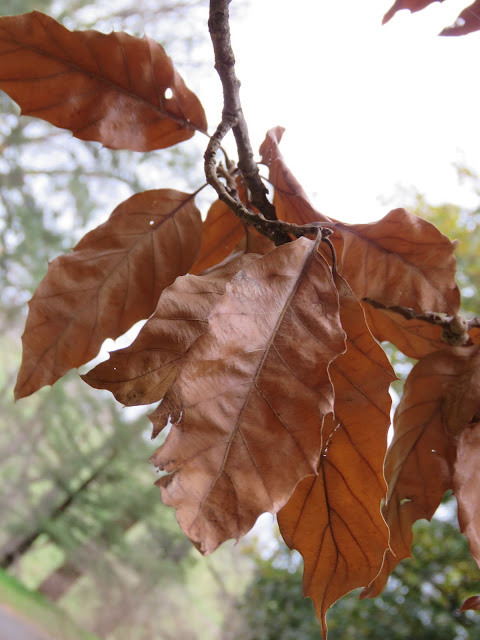Bristle-tipped oak and Chinese cork oak always at home in East Asia
 |
| Bristle-toothed oak, Kyneton Botanic Gardens, June 2020 |
A few winters ago, I saw two bristle-toothed oaks (Quercus acutissima) with their rusty brown leaves about to fall in Kyneton and then two days later, in Hawthorn. Like many deciduous oaks, they hold their leaves until early winter.
 |
| Bristle-toothed oak, Kyneton Botanic Gardens, June 2020 |
I've also seen bristle-toothed oaks in green leaf, in Box Hill Gardens and lakeside at Royal Botanic Gardens Melbourne. But they are not commonly grown in Australia.
Apparently, they are more often planted in North America, where they have escaped and become established in forests outside parks and gardens. Their natural home is in East Asia, including China, Korea and Japan.
 |
| Bristle-toothed oak, Fairview Park, Hawthorn, June 2020 |
The leaves, as you can see, are hardly lobed but do have those bristly spines on their margins. Not unlike the red oaks, but also like cork oak. They can also be a little narrower and more 'fusiform', as in the next leaf from Box Hill (although with oaks, you can never discount individuals being hybrids of some kind).
 |
| Bristle-toothed oak, Box Hill Gardens, May 2023 |
The scaly adornments on the acorn cups are not unlike those of the valonia and Turkey oaks. The cork oak does have slightly extended scales on its acorn cups, but less exuberantly so.
 |
| Bristle-toothed oak, Fairview Park, Hawthorn, June 2020 |
These days, oak experts include all four species - bristle-tipped, valonia, Turkey and cork - in the section Cerris of subgenus Cerris. (In case you are wondering, the similar-in-some-ways holm oak is in section Ilex of subgenus Cerris.)
About 15 of the 400 or so known oak species are classified in this section, with most of them occuring naturally in 'western Eurasia': that is, throughout most of middle and southern Europe through to areas around the Black Sea and slightly further east. The bristle-tipped oak, along with the Chinese cork oak (Quercus variabilis), is one of just two (or three if Quercus chenii is not considered the same as the britle-tipped oak) species from East Asia.
 |
| Chinese cork oak, Nanning, China; June 2020 |
I saw the Chinese cork oak on my most recent visit to China, in the botanic garden (Qing Xai Shan) in Nanning, to the west of Hong Kong. The species is native to the Guangxi region, but I think planted where I saw it within the botanic garden.
Unlike the specimen growing in Royal Botanic Gardens Melbourne, which I had only 'discovered' in the collection a few months earlier, the bark was hardly corky. But you see from the, presumably older, tree in Melbourne, it can be as chunky as that of Quercus suber (the 'regular' cork oak).
 |
| Chinese cork oak, Royal Botanic Gardens Melbourne; July 2020 |
It's also worth noting that the Melbourne tree has mostly green leaves in July, suggesting it is evergreen like the regular cork oak. And you can see that its leaves are not unlike those of the briste-toothed oak in general form.
 |
| Chinese cork oak, Royal Botanic Gardens Melbourne; July 2020 |
In a 2018 molecular study of the section Cerris (mostly focusing on the Eurasian species), these two East Asia species were considered to be in a separate evolutionary lineage to the vast majority of species in this section.
There are a hundred or more other oaks in Asia, most of them once included in a separate genus called Cyclobalanopsis. Those oak experts I mentioned above would these days consider Cyclobalanopsis to be a section (also called Cyclobalanopsis) of the subgenus Cerris.
Which implies a common ancestor for the so-called ring-cupped oaks ('Cyclobalanopsis') with the group containing the bristle-tipped, Chinese cork, cork, Turkey and valonia oaks. From a combination of fossil and molecular evidence, it seems that ancestor may have resided in eastern Asia. Which make sense because although predominantly around Europe today, the precursors of section Cerris itself can be tracked back to northern East Asia, in a remote part of Russia.
Comments